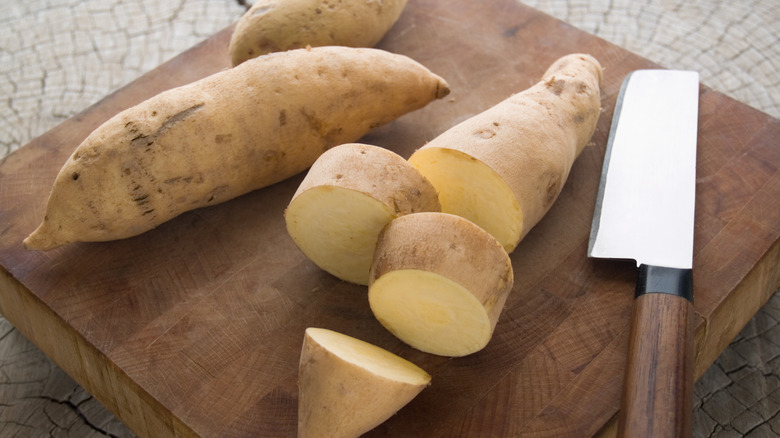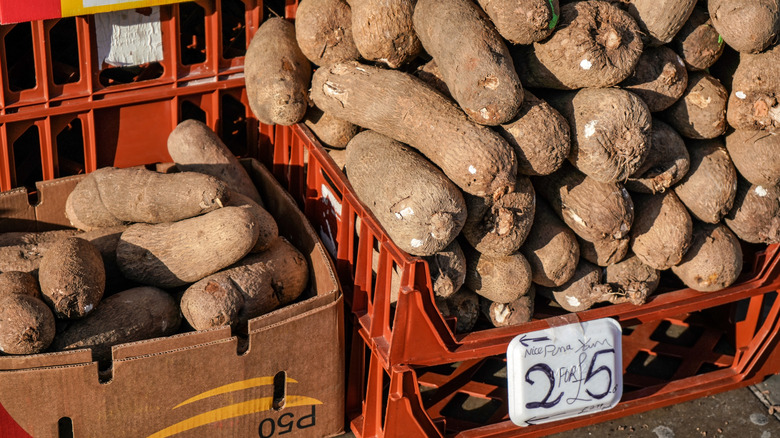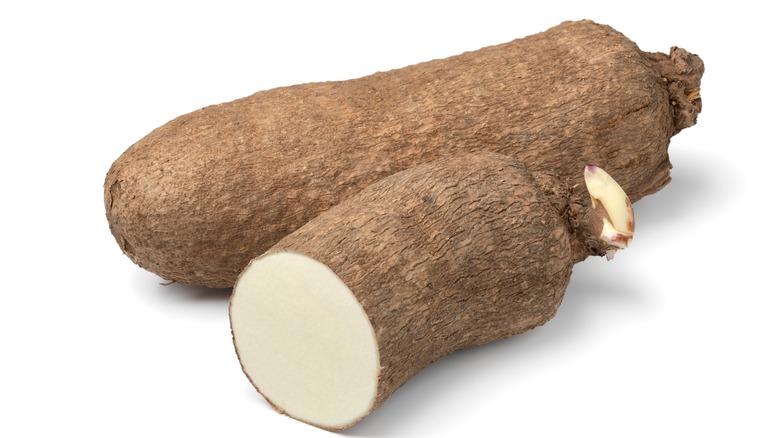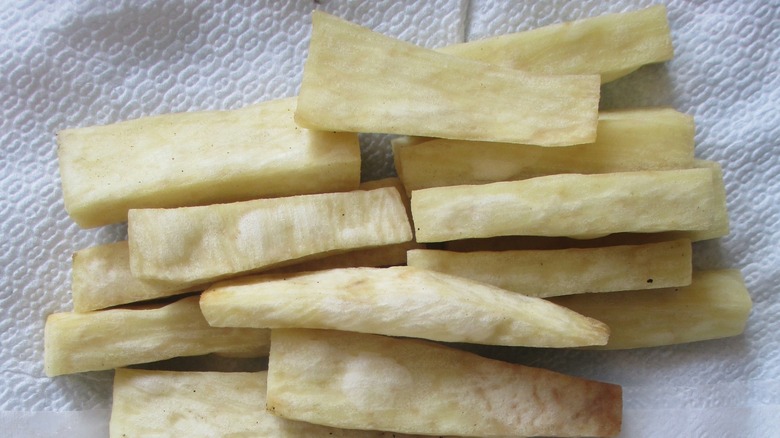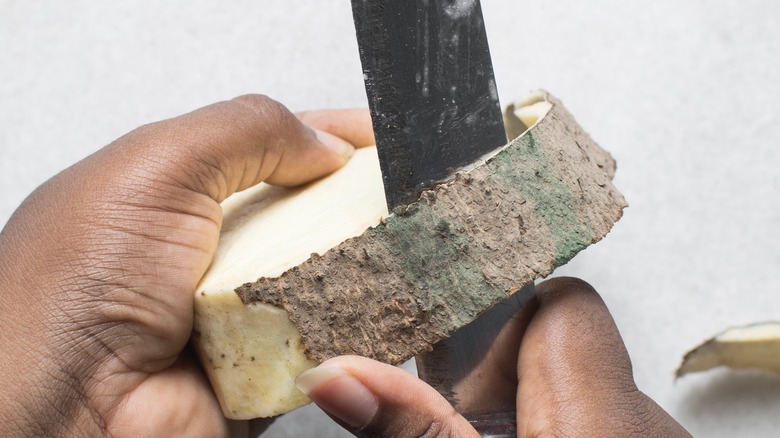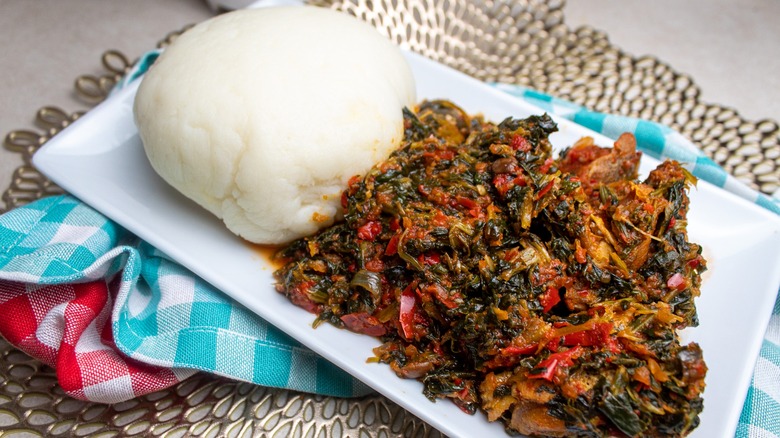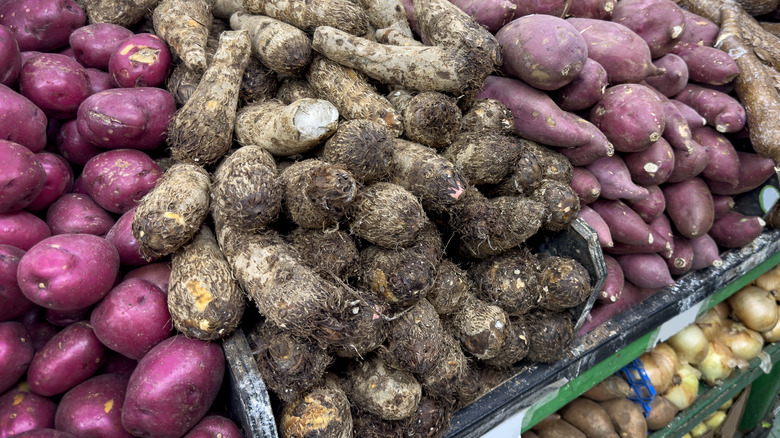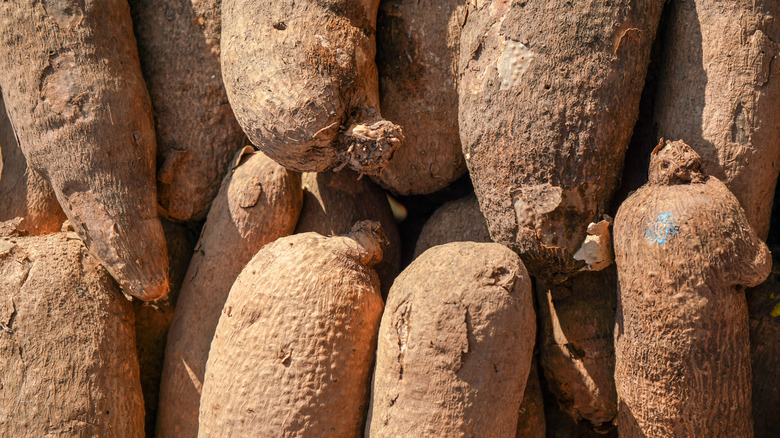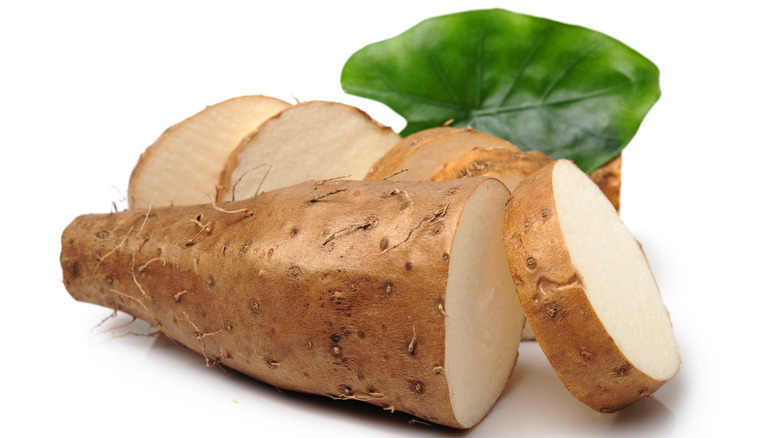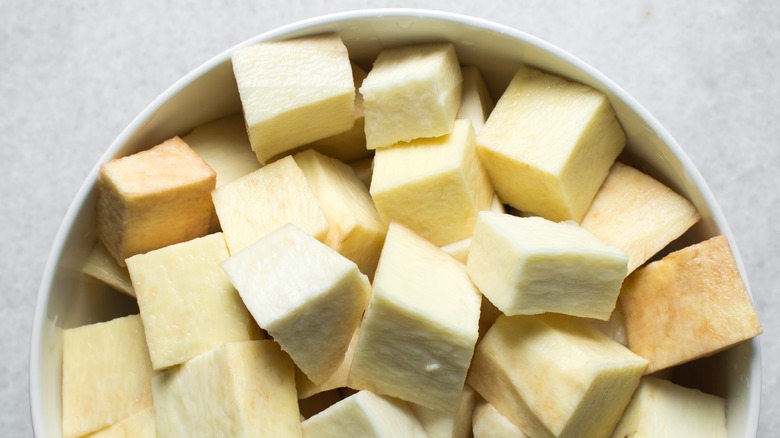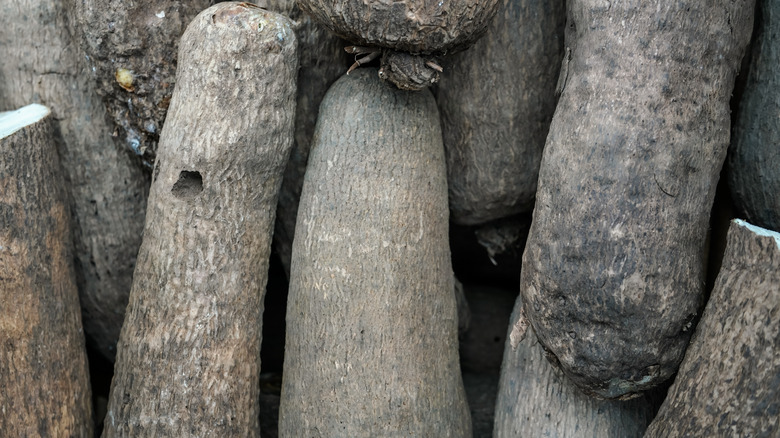What Are Puna Yams And What Do They Taste Like?
The humble but versatile puna yam isn't that well-known in the U.S., however, if you live in a city with a robust international grocery scene, you may have come across this white yam variety without realizing it. If you find a white yam in a market — assuming the seller didn't just label white sweet potatoes incorrectly, or get their yam varieties mixed up — there's a good chance that you're looking at a puna yam. This variety is one of the most widely grown tubers in West Africa, and they make an interesting substitute for both sweet potatoes and basic potatoes.
Yams have been getting more attention over the past few years as more people learn about why the name "yam" is often misapplied to certain orange tubers like jewel yams — better known as sweet potatoes. It doesn't hurt that other varieties of yams, such as ube, have skyrocketed in popularity in the U.S. and raised the profiles of yams in general. Puna yams may not be sold everywhere right now, but they're worth seeking out if you want a starchy vegetable that acts as a nice base for most other food. We take a look at what puna yams are and what they taste like.
What are puna yams?
The puna yam is a white-fleshed tuber that's very popular in West Africa, especially in countries like Nigeria and Ghana. These are typically large but can grow anywhere from 6 to 100 pounds, however, those sold in markets are usually under 11 pounds, and those 100-pound behemoths are specially cultivated in optimal settings. They tend to be shaped like long sweet potatoes, and the skin is a very rough, dark brown, with an appearance similar to tree bark. The skin is relatively thin but can be hard to remove, especially if the yam is older, and the interior is usually white to off-white.
Puna yams grow well and can be very resistant to diseases. They're a major home and cash crop in West Africa, and it's thought that the yam has been grown for nearly 3,000 — possibly even for 5,000 — years. Puna yams are a domesticated cultivar that's a descendant of a wild yam species, and the yam even has a place in some cultural and religious festivals, including the New Yam Festival celebrated by the Ogidi community in Nigeria.
Puna yams are sometimes confused with the sweet potato
No investigation of yams is complete without a look at why so many orange sweet potatoes are mistakenly also called yams. The answer lies in both the marketing of the product and with people trying to find food that resembled what they ate back home. When enslaved Africans were brought over to North America, they no longer had access to the African yams that they were used to. They used the white sweet potato as a substitute, calling it a yam just because of how similar it was and because they were using it in a very similar way. White sweet potatoes, such as the Hannah variety, are somewhat firmer than orange sweet potatoes, so they were an acceptable substitute for yams at the time.
Later, in the 1930s, farmers who wanted to sell orange sweet potatoes had to think of a way to separate them in people's minds from the white sweet potato. They started calling the orange sweet potato a yam simply so that buyers wouldn't end up buying the wrong type of sweet potato. Why they just didn't call it an orange sweet potato is unknown, but they went with "yam," and that's what many people have grown up calling the orange tubers.
What do puna yams taste like?
If you don't like very sweet foods, then seek out puna yams. They're sweet but only mildly so, and they tend to be described as earthy and relatively neutral. They're a great carbohydrate to have with meals where you want to emphasize other tastes while still having something that adds bulk. They soak up other flavors, so if you do want the yam portion of your meal to taste a little bolder, add a sauce or place it in a stew.
The texture can be dry and is more substantial than that of a potato. Depending on how you prepare the yam, the final texture can be solid enough to serve as a sort of utensil for scooping up food. If you fry the yam, be aware that it will take on that flavor, so use good-tasting oil that hasn't been sitting around for weeks. Puna yam is an unassuming food in terms of taste, but that makes it a great, versatile addition to many different types of recipes.
Is the peel edible?
Unlike a potato, the peel or skin of the puna yam isn't edible and has to be removed before cooking. The easiest way to do this is to slice the yam into rounds and then cut the skin off either by chopping it off in bits or peeling it like you would an apple. If you try to remove the skin from a whole yam, you'll find it hard to do because the skin is so tough (those comparisons to tree bark aren't just based on looks). If you are preparing a puna yam, you can experiment with the different methods of peeling to see which is faster for you.
Once you cut into the yam, the flesh will begin to discolor. You will need to have a bowl of cold water ready when you start cutting the yam and should place the peeled slices or pieces into the water as you finish removing the skin from each. The water should be enough to stop or at least reduce discoloration.
Warning: Raw yam can irritate skin in some cases
Peeling raw puna yam sounds like it should be easy, but there's a catch: The raw yam can irritate your skin and make your hands feel itchy. Technically you can hold it with your bare hands, but the advice is to keep this to a minimum. You could always try wearing food-preparation gloves if you didn't want to risk getting a rash.
Two reviews in 2020, one in the journal Foods and the other in Frontiers in Pharmacology, both identify calcium oxalate as a main culprit behind the irritation. Oxalates are present in many plants, including spinach, but touching raw spinach doesn't make your hands itch. So why are the oxalates found in yams such a problem? Hong Kong's Centre for Food Safety explains that oxalates come in different shapes. The ones in yam are called raphides, which are needle-shaped. Damaging the cells of the yam, such as through cutting or chewing, causes the raphides to be pushed out into whatever is nearby — usually your hands. Foods with high raphide levels, like wild taro root, are usually inedible. But cooking yams thoroughly helps reduce the effect of the calcium oxalates, with boiling being one of the better methods. Just don't skimp on time — prepare puna yams only when you can let them cook for as long as needed. If you have issues with kidney stones, speak with your doctor about whether you can eat yams because of their calcium oxalate content.
Warning: Never eat raw puna yam
As well as being potentially irritating to your skin, the calcium oxalate raphides in raw yams can also be bad for your mouth and throat if proper precautions aren't taken. But that's not all, folks. Most yams, including puna yams, contain proteins that are toxic when ingested in their raw form. Cooking neutralizes these toxins, so properly cooked puna yam is safe to eat for most. But we can't stress this enough: Don't eat raw puna yams, and please handle them very carefully if your hands are bare.
Remedies for itchy hands after cutting yams vary. Some of the easier methods include washing your hands well with dish soap and cold water and taking over-the-counter pain relievers. Other methods include covering your hands with different oils, but these aren't proven. Be wary of advice that contradicts other safety measures. If you can't get rid of the itching, or if you've accidentally eaten raw yam, contact your doctor.
How to cook (and cook with) puna yams
You can cook puna yams in several different ways. You must always remove the peel, and the yams are typically sliced, chopped, or grated before the pieces are boiled in water. However, you can also fry them, microwave them, mash them after boiling, dry them in the sun and then grind them into flour, or pound them into a paste. If you eat them after only boiling them, you might want to mix them with sauces as some sources say the yam can taste very dry on its own. The cooked yam can also be mixed with other vegetables. In other words, once that yam is cooked, it can be used pretty much like any other tuber.
One well-known dish is called fufu or pounded yam. Boiled yam chunks are pounded in a mortar with a pestle until the meal becomes smooth. The process can take a while but produces a ball-shaped dough that's nothing like mashed yams. Use pieces of the dough to form a scoop for other foods including soup. Fufu is traditionally swallowed without chewing unless the food you're scooping up has to be chewed, so if you serve fufu with food that doesn't need to be chewed, keep those pieces small.
Where to find puna yams
Finding puna yams in the U.S. isn't impossible, but it's not easy and can depend entirely upon where you live. African and Caribbean markets should have them, and if you're lucky enough to live near an international market or a grocery store that carries a lot of different produce from around the world, you just might find puna yams and maybe a few other varieties as well. Farmer's markets may have them, too, and don't sleep on big-box stores that carry a wide variety of produce, either. If the markets near you aren't that diverse in what they sell, however, you might not be able to find any yams, let alone puna yams.
You can find a number of specialty grocers online, and some do sell the yams, but there's an important caveat. When you buy produce online, there's no telling what the quality is like. Buying food in person allows you to see the item and ensure it's in good condition, but buying online forces you to rely on the shipper to get something that's in good shape. Ask around to find a reputable seller before making a purchase. Yams are usually available year-round, but that doesn't mean each seller will always have them for sale when you need them.
Nutrition information for puna yams
The basic nutritional profile of a puna yam includes lots of fiber, potassium, vitamin C, calcium, folate, and magnesium. The yams have smaller amounts of minerals and vitamins like iron, zinc, and vitamin E. These are thought to improve digestion, fluid regulation, and the immune system. Like other tubers, puna yams are carbohydrate-heavy, which provides the energy your body needs to function.
If you have hormonal issues, particularly those related to estrogen, then you may need to exercise caution before eating yams. Another yam species, also called wild yam, contains a substance called diosgenin. This is a phytoestrogen that has traditionally been used to treat menstrual issues. A 2005 study showed that ingestion of a yam variety better known as ube — yes, that ube — also had an estrogenic effect on postmenopausal women. If you have hormonal issues or are taking hormones, you might want to speak with your doctor before eating any yam species to ensure what you eat won't affect what you take.
Are there different varieties of puna yams?
The puna yam is a specific variety of white yams, and while all puna yams are white yams, not all white yams are specifically puna yams. Still, the puna yam is also called white yam, white Guinea yam, African yam, Nigerian yam, and true yam. This can make finding the yams rather bewildering if the only sign you see at a market is "white yam." You'll have to look at the skin and interior to see if they match the description for puna yams. Thankfully, other white yams do look somewhat different. For example, one of those white yams is the Ghana yam, which has smoother and whiter skin than the puna yam.
The fun with names doesn't end there, unfortunately. A yellow yam is also called the Guinea yam even though it's a different species, so finding a "Guinea yam" doesn't necessarily mean you've found a puna yam. There's a white version of the yellow yam, too, according to the University of Florida, so it is a bit of a minefield to find the exact one you want.
How to store puna yams
Store uncut puna yams like you might store potatoes or sweet potatoes, with a couple of minor variations. Keep the yams in a cool, dark place that has good ventilation. The yams can develop mold easily if the storage spot is closed up and doesn't have good air flow. Mold is also a risk if you place them in the refrigerator or keep them wrapped tightly in plastic, and the cooler temperatures in a refrigerator can make the yams taste and smell bad. You might see sources claim you can store them for weeks in a plastic bag, but most recommend ensuring air flow around the yams. Storage times vary by source and range from two weeks to four months.
One you cut, grate, or cook the yams, however, store them in the refrigerator or freezer. If storing in the fridge, cover the yams with water in a large bowl. Be aware that the yam may still become a bit discolored. If freezing, you only have to place the yams in a zippered freezer bag, squeeze the air out, and put the bag in the freezer (My Sasun African Market recommends adding a tablespoon of baking soda to the bag). It may help to place the yam pieces on a tray in a single layer and freeze them for a short time before you put them in the final freezer container, just like you'd do when freezing fruit.
Can you grow puna yams in a home garden?
If you don't live near a market that carries puna yams, and you live in a region suitable for growing tubers, you could try growing the yams in your own garden. Yams do well in warmer growing zones, but you'll need enough room for the aboveground vines to grow. Those can range from 10 to 15 meters long, or approximately 32 to 49 feet long. Vines need to be staked and separated so that there's enough air circulation to prevent fungi from growing. That warning that you need space isn't an exaggeration.
Something interesting that you'll see when learning about growing yams is a process called "milking." This isn't a process for creating yam-based milk, but rather a way to ensure you have more seed yams that you can plant in the future. Seed yams are what you plant in order to grow yams, similar to using seed potatoes for growing a potato crop. Milking involves harvesting young, good-quality yams (called ware yams, meaning they're being grown for sale), cutting the heads (the part where the vine attaches) of them off, and replanting the heads. These grow into small yams that are stored for planting the next year.
